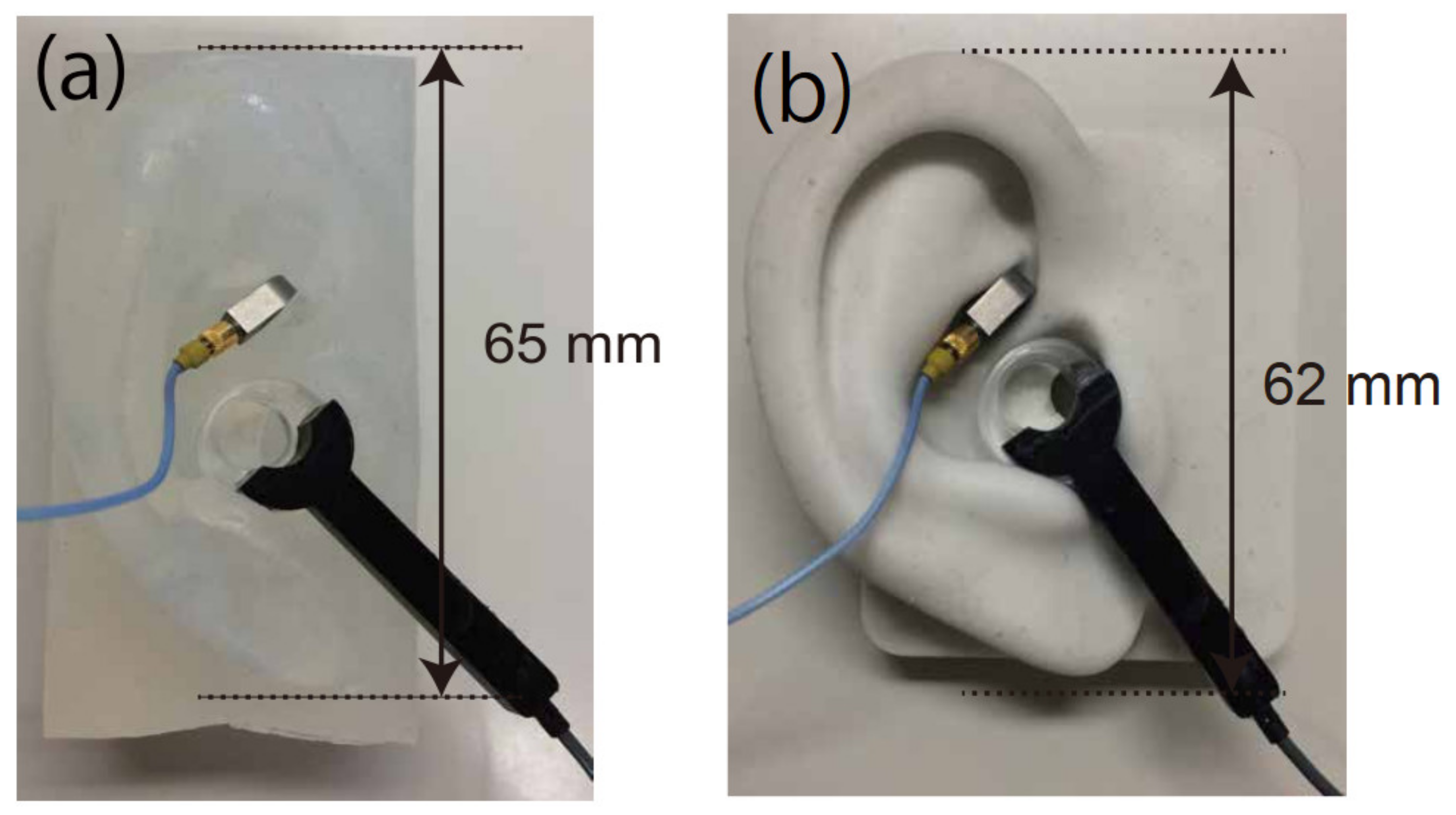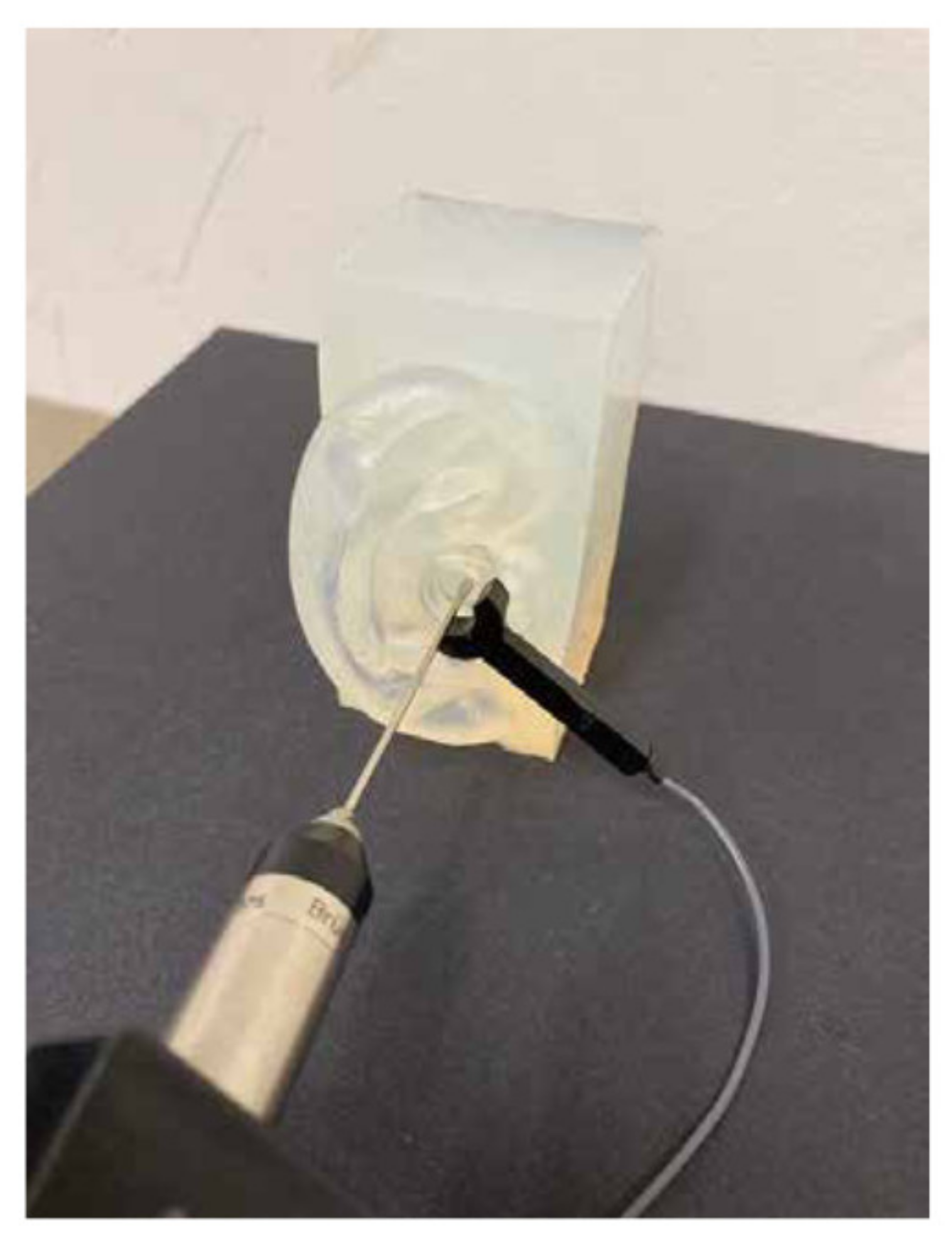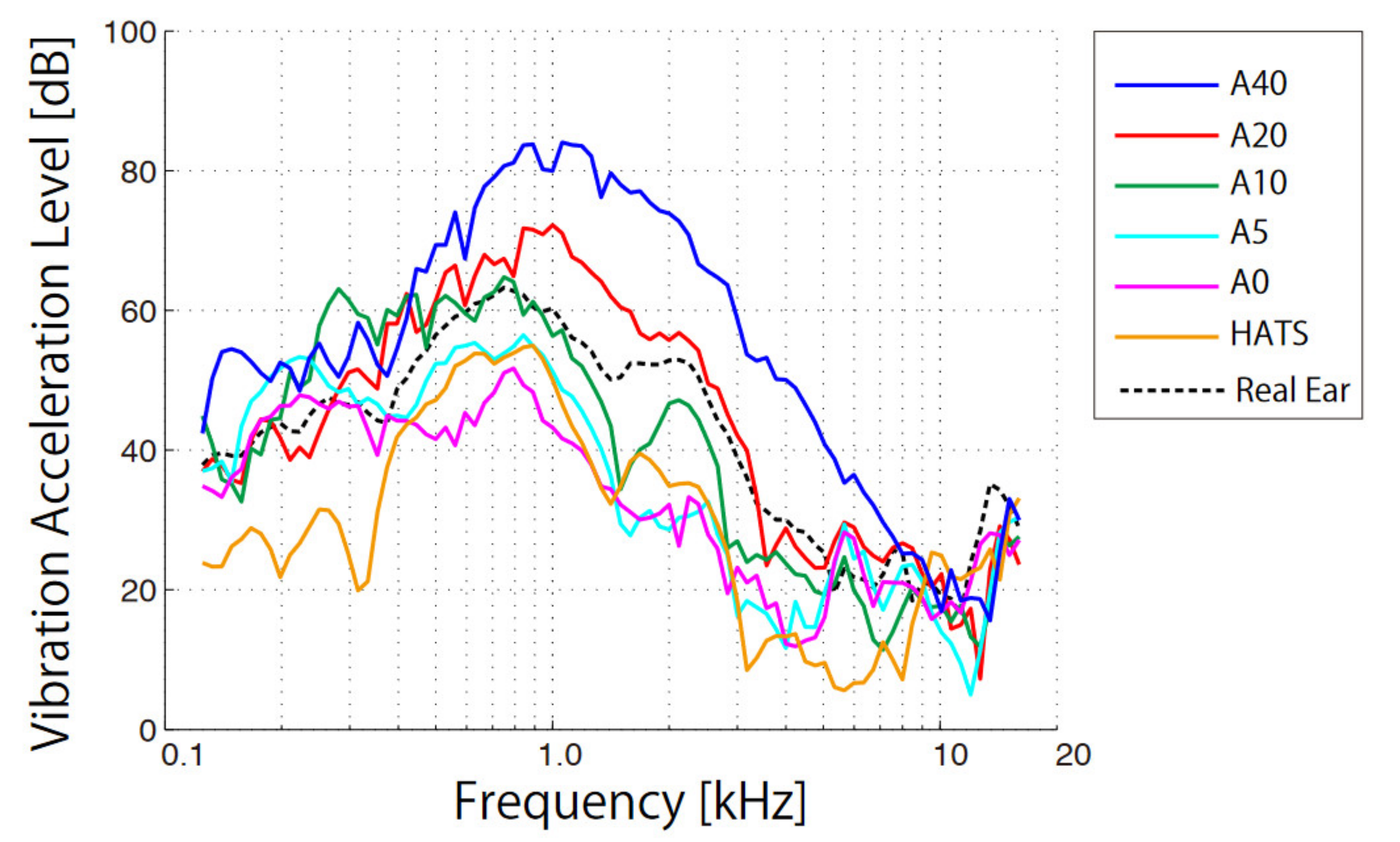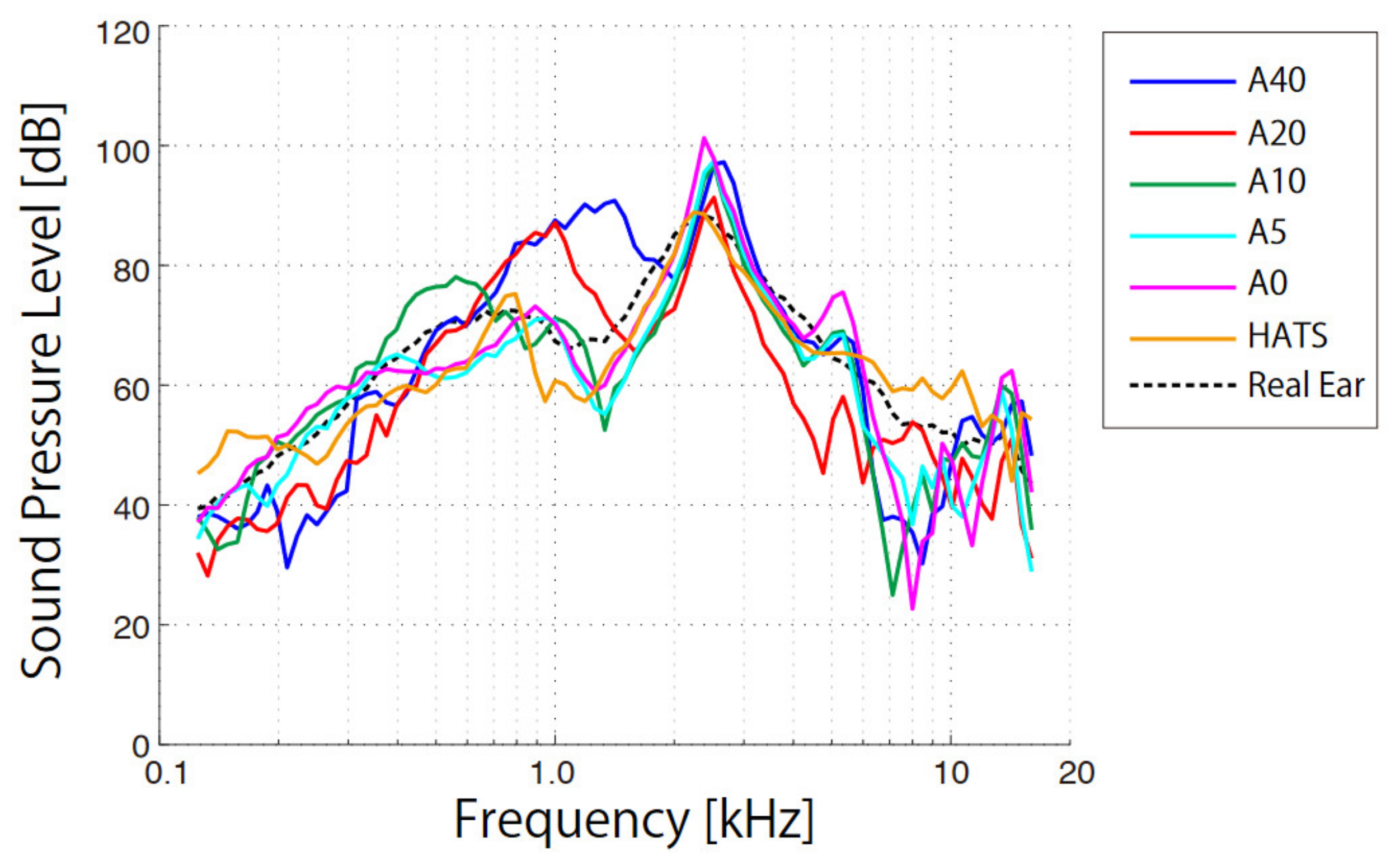Vibrational and Acoustical Characteristics of Ear Pinna Simulators That Differ in Hardness
Abstract
:1. Introduction
2. Method
2.1. Pinna Simulators
2.2. Cartilage Conduction Transducer
2.3. Measurement Procedures for Vibration
2.4. Measurement Procedure for Sound
3. Results
4. Discussion
Limitation of the Study
5. Conclusions
Author Contributions
Funding
Institutional Review Board Statement
Informed Consent Statement
Data Availability Statement
Acknowledgments
Conflicts of Interest
References
- Hosoi, H. Receiver. Japanese Patent Application Number 166644, 4 June 2004. [Google Scholar]
- Hosoi, H. Approach in the Use of Cartilage Conduction Speaker. Japanese Patent Number 4541111, 17 November 2004. [Google Scholar]
- Shimokura, R.; Hosoi, H.; Iwakura, T.; Nishimura, T.; Matsui, T. Development of monaural and binaural behind-the-ear cartilage conduction hearing aids. Appl. Acoust. 2013, 74, 1234–1240. [Google Scholar] [CrossRef]
- Nishimura, T.; Hosoi, H.; Sugiuchi, T.; Matsumoto, N.; Nishiyama, T.; Takano, K.; Sugimoto, S.; Yazama, H.; Sato, T.; Komori, M. Cartilage conduction hearing aid fitting in clinical practice. J. Am. Acad. Audiol. 2021. [Google Scholar] [CrossRef]
- Nishimura, T.; Hosoi, H.; Shimokura, R.; Morimoto, C.; Kitahara, T. Cartilage conduction hearing and its clinical application. Audiol. Res. 2021, 11, 254–262. [Google Scholar] [CrossRef]
- Shimokura, R.; Hosoi, H.; Nishimura, T.; Yamanaka, T.; Levitt, H. Cartilage conduction hearing. J. Acoust. Soc. Am. 2014, 135, 1959–1966. [Google Scholar] [CrossRef] [PubMed]
- Nishimura, T.; Hosoi, H.; Saito, O.; Miyamae, R.; Shimokura, R.; Matsui, T.; Yamanaka, T.; Levitt, H. Is cartilage conduction classified into air or bone conduction? Laryngoscope 2014, 124, 1214–1219. [Google Scholar] [CrossRef] [PubMed]
- Nishimura, T.; Hosoi, H.; Saito, O.; Miyamae, R.; Shimokura, R.; Yamanaka, T.; Kitahara, T.; Levitt, H. Cartilage conduction is characterized by vibrations of the cartilaginous portion of the ear canal. PLoS ONE 2015, 10, e0120135. [Google Scholar] [CrossRef] [PubMed]
- Hosoi, H.; Nishimura, T.; Shimokura, R.; Kitahara, T. Cartilage conduction as the third pathway for sound transmission. Auris Nasus Larynx 2019, 46, 151–159. [Google Scholar] [CrossRef] [PubMed] [Green Version]
- Morimoto, C.; Nishimura, T.; Hosoi, H.; Saito, O.; Fukuda, F.; Shimokura, R.; Yamanaka, T. Sound transmission of cartilage conduction in the ear with fibrotic aural atresia. J. Rehabil. Res. Dev. 2014, 51, 325–332. [Google Scholar] [CrossRef] [PubMed]
- Nishimura, T.; Hosoi, H.; Saito, O.; Shimokura, R.; Yamanaka, T.; Kitahara, T. Cartilage conduction hearing aids for sever conduction hearing loss. Otol. Neurotol. 2018, 39, 65–72. [Google Scholar] [CrossRef] [PubMed]
- ISO 389-2, Acoustics—Reference zero for the Calibration of Audiometric Equipment—Part 2: Reference Equivalent Threshold Sound Pressure Levels for Pure Tones and Insert Earphones; International Organization for Standardization: Geneva, Switzerland, 1994.
- ISO 389-3, Acoustics—Reference Zero for the Calibration of Audiometric Equipment—Part 3: Reference Equivalent Threshold Force Levels for Pure Tones and Bone Vibrators; International Organization for Standardization: Geneva, Switzerland, 1994.
- IEC 60318-7, Electroacoustics—Simulations of Human Head and Ear—Part 7: Head and Torso Simulator for the Measurement of Hearing Aids; International Electrotechnical Commission: Geneva, Switzerland, 2011.
- IEC 60318-4, Electroacoustics—Simulations of Human Head and Ear—Part 4: Occluded-Ear Simulator for the Measurement of Earphones Coupled to the Ear by Means of Ear Inserts; International Electrotechnical Commission: Geneva, Switzerland, 2010.
- Shimokura, R.; Hosoi, H.; Nishimura, T.; Iwakura, T.; Yamanaka, T. Simulating cartilage conduction sound to estimate the sound pressure level in the external auditory canal. J. Sound Vib. 2015, 335, 261–268. [Google Scholar] [CrossRef]
- JIS Z 2280-1993, Test Method for Youngʼs Modulus of Metallic Materials at Elevated Temperature; Japanese Industrial Standards Committee: Tokyo, Japan, 1993.
- Gent, A.N. On the relation between indentation hardness and Young’s modulus. Inst. Rubber Ind. Trans. 1958, 34, 46–57. [Google Scholar] [CrossRef]
- Pampush, J.D.; Daegling, D.J.; Vick, A.E.; Mcgraw, W.S.; Covey, R.M.; Rapoff, A. Technical Note: Converting durometer data into elastic modulus in biological materials. Am. J. Phys. Anthropol. 2011, 146, 650–653. [Google Scholar] [CrossRef] [PubMed]





Publisher’s Note: MDPI stays neutral with regard to jurisdictional claims in published maps and institutional affiliations. |
© 2021 by the authors. Licensee MDPI, Basel, Switzerland. This article is an open access article distributed under the terms and conditions of the Creative Commons Attribution (CC BY) license (https://creativecommons.org/licenses/by/4.0/).
Share and Cite
Shimokura, R.; Nishimura, T.; Hosoi, H. Vibrational and Acoustical Characteristics of Ear Pinna Simulators That Differ in Hardness. Audiol. Res. 2021, 11, 327-334. https://doi.org/10.3390/audiolres11030030
Shimokura R, Nishimura T, Hosoi H. Vibrational and Acoustical Characteristics of Ear Pinna Simulators That Differ in Hardness. Audiology Research. 2021; 11(3):327-334. https://doi.org/10.3390/audiolres11030030
Chicago/Turabian StyleShimokura, Ryota, Tadashi Nishimura, and Hiroshi Hosoi. 2021. "Vibrational and Acoustical Characteristics of Ear Pinna Simulators That Differ in Hardness" Audiology Research 11, no. 3: 327-334. https://doi.org/10.3390/audiolres11030030
APA StyleShimokura, R., Nishimura, T., & Hosoi, H. (2021). Vibrational and Acoustical Characteristics of Ear Pinna Simulators That Differ in Hardness. Audiology Research, 11(3), 327-334. https://doi.org/10.3390/audiolres11030030







